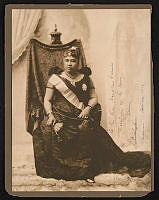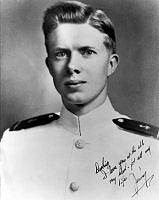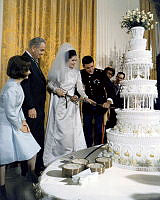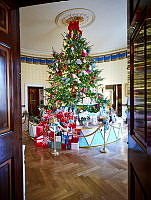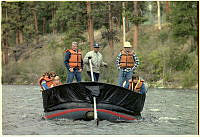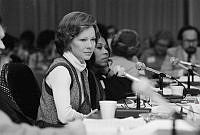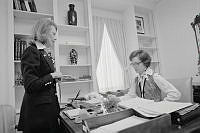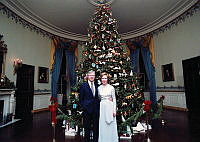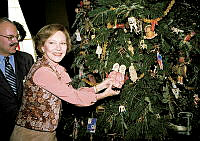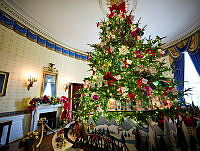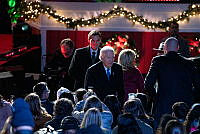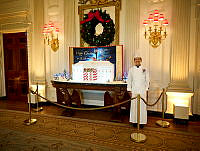Nancy Reagan

Nancy Davis (Anne Frances Robbins) was born on July 6, 1921, in New York City. Her parents, Kenneth Robbins and Edith Luckett, separated after their daughter’s birth. Anne was sent to live with Edith’s sister, Virginia Gailbraith, and her husband Audley for the next six years. After Edith married Loyal Edward Davis in 1929, she and Anne reunited in Chicago, Illinois. Anne later changed her name to Nancy Davis after Loyal formally adopted her.1
After graduating from Chicago’s Girls’ Latin School, Nancy attended Smith College where she studied Drama and English. She received her degree in 1943 and pursued an acting career. Nancy worked in theater, as well as film and television productions. Through these experiences and professional networks, she met fellow actor and Screen Actors Guild (SAG) Board member Ronald Reagan. They began dating and were later married on March 4, 1952, at the Little Brown Church in San Fernando Valley, California. The Reagans had two children together – Patricia Ann Reagan (Patti Davis) and Ronald Prescott Reagan (Ron). Ronald also had two children from a previous marriage – Maureen and Michael.
Nancy supported her husband’s film career and transition into politics. In 1966, he was elected governor of California and she took on the role of first lady of California. She became more active in a variety of charitable causes, visiting with recuperating veterans, the elderly, and children with emotional or physical challenges. These encounters sparked her support of the Foster Grandparent Program, which paired seniors with children, and she later became an advocate for its expansion.2
In 1980, Ronald Reagan defeated President Jimmy Carter in a landslide election. The Reagans ushered in a new era of hospitality at the White House – more than 50 State Dinners in eight years’ time, as well as countless receptions, dinners, and events that featured stars of stage and screen mingling with politicians, dignitaries, musicians, and other luminaries.
Mrs. Reagan oversaw a major redecoration of the Private Quarters and commissioned a new State Service outfitted with her favorite color – red. While these activities and items were funded privately, the optics generated considerable criticism of the first lady as the country continued to experience a recession.
Mrs. Reagan then decided she would take on drug and alcohol abuse as her initiative. She traveled throughout the country and abroad, highlighting the perils of substance abuse and encouraging young people to “Just Say No.” She met with students, parents, and addicts, visited prevention programs and rehabilitation centers, and even addressed the Third Committee of the United Nations General Assembly on the subject in 1988 – the first sitting first lady to do so.3
In 1987, Nancy Reagan underwent a radical mastectomy after a cancerous lesion was discovered during a mammogram. Like her predecessor Betty Ford, Mrs. Reagan shared her diagnosis with the public and urged women to visit their doctors for screenings. In 1989, Mrs. Reagan published My Turn: The Memoirs of Nancy Reagan.
After the White House, she continued to advocate against drug and alcohol abuse, establishing the Nancy Reagan Foundation in 1994 and developing the Nancy Reagan Afterschool Program. That same year, her husband announced his diagnosis of Alzheimer’s disease. In his letter to the American people, President Reagan explained that he and Nancy believed sharing this news would help increase public awareness and hoped it might provide a better understanding of the people affected by Alzheimer’s.4
For the next ten years, Nancy cared for her husband and played a critical role in shaping his legacy. She was very active with the Ronald Reagan Presidential Library, served on the Board of the Ronald Reagan Presidential Foundation, and participated in the Reagan centennial celebration in 2011. In 2002, Mrs. Reagan was awarded the Presidential Medal of Freedom from President George W. Bush. She raised awareness for Alzheimer’s disease and urged more federal funding for stem cell research as a possible treatment. On March 6, 2016, Nancy Davis Reagan passed away and was buried next to President Reagan on the grounds of the Ronald Reagan Presidential Library.5
Footnotes & Resources
- Biography of Nancy Davis Reagan, Ronald Reagan Presidential Library & Museum, https://www.reaganlibrary.gov/reagans/nancy-reagan/biography-nancy-davis-reagan
- Ibid.
- Biography of Nancy Davis Reagan, Ronald Reagan Presidential Library & Museum, https://www.reaganlibrary.gov/reagans/nancy-reagan/biography-nancy-davis-reagan
- https://www.reaganlibrary.gov/reagans/ronald-reagan/reagans-letter-announcing-his-alzheimers-diagnosis#:~:text=When%20the%20Lord%20calls%20me,Thank%20you%2C%20my%20friends.
- Ibid.













